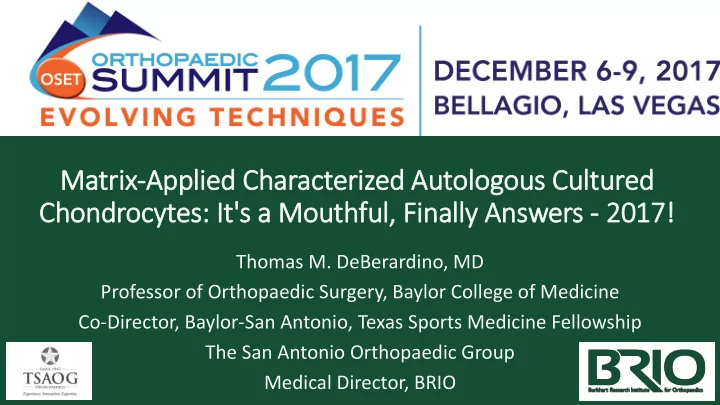

OSET Matr trix ix-App Applied ed C Character erized A ed Autolog ogous ous Cultur ured ed Cho Chondrocytes: I It's a a Mout uthful, F Final nally A Ans nswers - 2017! 2017! Thomas M. DeBerardino, MD Professor of Orthopaedic Surgery, Baylor College of Medicine Co-Director, Baylor-San Antonio, Texas Sports Medicine Fellowship The San Antonio Orthopaedic Group Medical Director, BRIO
Disclosure • The following relationships with commercial interests related to this presentation existed during the past 12 months: • Research support: MTF and Arthrex • Consultant: Arthrex, MTF • Dr. DeBerardino does not intend to discuss the use of any off-label use/unapproved use of drugs or devices
Cartilage Restoration • Unified Goal: • Find a method that demonstrates significant advantage over the others for improving joint function • Problem: • Outcomes have failed to produce histologically comparable cartilage that mimics the complex zonal architecture of native hyaline cartilage with optimal long-term implications
Holy Grail • Cartilage regeneration techniques must be: • Cost effective • Single stage (hopefully some day) • Patient friendly
U.S. Cartilage Market
Autologous Cartilage Restoration Options • OATS • OCA • Cell-cased therapies • MACI • NeoCart • Novocart 3D
Scaffold/Cell Based Cartilage Restoration • Long basic science and clinical history • Autologous cells seem best • Trend is cells in matrix
Cell/Scaffold Restoration • Open surgery • Best with little/no bone loss • Limited weight bearing • Motion recommended
Cell/Scaffold Advantages • Can support multiple lesions and sizes without need for multiple grafts (OCAs) • Planned two stage operation makes logistically less challenging
Cell/Scaffold Disadvantages • Two-staged operation- (one-staged options being studied) • Nonstructural at time zero • Expensive
Background • Despite introduction of autologous chondrocyte therapy for repair of hyaline articular cartilage injury in 1994, microfracture remains a primary standard of care • NeoCart, an autologous cartilage tissue implant, was compared with microfracture in a multisite prospective, randomized trial of a tissue- engineered bioimplant for treating articular cartilage injuries in the knee Crawford DC, DeBerardino TM, Williams RJ 3 rd . NeoCart, an autologous cartilage tissue implant, compared with microfracture for treatment of distal femoral cartilage lesions: an FDA phase-II prospective, randomized clinical trial after two years. J Bone Joint Surg Am, 2012. 94(11):979-89
Methods • 32 patients randomized at a ratio of two to one (two were treated with an autologous cartilage tissue implant [NeoCart] for each patient treated with microfracture) at the time of arthroscopic confirmation of an ICRS grade-III lesion(s) • Microfracture or cartilage biopsy was performed • NeoCart, produced by seeding a type-I collagen matrix scaffold with autogenous chondrocytes and bioreactor treatment, was implanted six weeks following arthroscopic cartilage biopsy • Standard evaluations were performed with validated clinical outcomes measures Crawford DC, DeBerardino TM, Williams RJ 3 rd . NeoCart, an autologous cartilage tissue implant, compared with microfracture for treatment of distal femoral cartilage lesions: an FDA phase-II prospective, randomized clinical trial after two years. J Bone Joint Surg Am, 2012. 94(11):979-89
Results • Significantly more NeoCart-treated patients (p = 0.0125) had responded to therapy (were therapeutic responders) at six months (43% versus 25% in the microfracture group) and twelve months (76% versus 22% in the microfracture group) • This trend continued, as the proportion of NeoCart-treated patients (15 of 19) who were therapeutic responders at 24 months was greater than the proportion of microfracture-treated participants (4 of 9) who were therapeutic responders at that time • Conclusions: NeoCart technique is associated with greater clinical efficacy at two years after treatment Crawford DC, DeBerardino TM, Williams RJ 3 rd . NeoCart, an autologous cartilage tissue implant, compared with microfracture for treatment of distal femoral cartilage lesions: an FDA phase-II prospective, randomized clinical trial after two years. J Bone Joint Surg Am, 2012. 94(11):979-89
NeoCart • Currently finishing up FDA Phase III Muli-Center Trial
Current Phase III Trial • The current phase III study is a multisite protocol with 33 study locations. This confirmatory study is a prospective randomized trial comparing the efficacy and safety of NeoCart to microfracture in the treatment of cartilage defects in the knee. The primary outcome measures are the change of physical functioning and pain as assessed by patient reported outcome measures of the KOOS (Knee injury and Osteoarthritis Outcome Score) and IKDC (International Knee Documentation Committee) scores.
Current Phase III Trial- 1 st Step • The initial surgery involves confirmation of appropriate inclusion and exclusion criteria • A cartilage biopsy is obtained arthroscopically and sent to Histogenics for the treatment group and microfracture is performed for the control group
Phase III Trial- 2 nd Step • 2 nd step for the treatment group occurs at about 6 weeks after biopsy • Neocart implant is produced via a collagenase extraction of chondrocytes • Cells are seeded onto a bovine type-I collagen matrix incubated in a bioreactor • A mini-arthrotomy allows direct access to the known lesion and the surgeon shaped Neocart implant is secured to the prepared based of the lesion using a proprietary collagen-based polymer (CT-3, Histogenics) • Both groups are treated with rehabilitation standardized to the same protocol recommended after microfracture • TTWB for six weeks with 6-8 hours of continuous active or passive motion • Sports restrictions are recommended for 6 months
Cartilage Restoration: Current Status • Cartilage lesion treatment options have become more numerous each year • Advances with autologous cartilage cell seeded scaffold-based products are showing early promising results • Current ongoing studies analyzing implants such as Neocart represent an important evolution in chondral lesion management
Cartilage Restoration: Current Status • Responder analysis will hopefully help identify patients and subgroups that are optimal candidates for similar cartilage restoration in the future • There have yet to be any clinical trials comparing one cell-based technology directly to another • Once clinical efficacy of the myriad of cartilage restorative procedures is documented, such comparative trials will certainly follow
Th Than ank Y You ou! Questions?
Recommend
More recommend